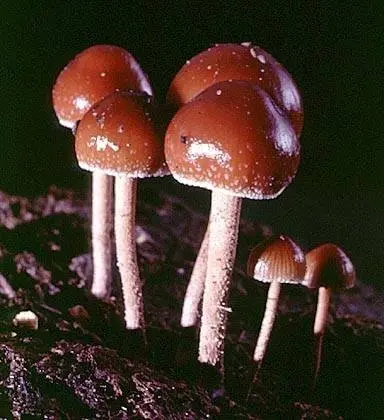Stropharia shitty (Deconica coprophila)
- Division: Basidiomycota (Basidiomycetes)
- Subdivision: Agaricomycotina (Agaricomycetes)
- Class: Agaricomycetes (Agaricomycetes)
- Subclass: Agaricomycetidae (Agaricomycetes)
- Order: Agaricales (Agaric or Lamellar)
- Family: Strophariaceae (Strophariaceae)
- Genus: Deconica (Dekonika)
- Type: Deconica coprophila
:

head with a diameter of 6 – 25 mm, at first hemispherical, sometimes with a small depression, becomes convex with age. The edge is first tucked inward, then gradually unfolds and becomes flat, in young mushrooms with the remains of a private cover in the form of white scales and an uneven white border. The color is light yellowish brown to dark reddish brown, becoming lighter and faded with age. The surface is hygrophanous, dry or sticky, shiny in wet weather, radially radiant in young mushrooms due to translucent plates. Pulp thin, of the same color as the cap, does not change color when damaged.
Leg 25 – 75 mm long and about 3 mm in diameter, straight or slightly curved at the base, fibrous, in young mushrooms often covered with whitish scales, occasionally with remnants of a private spathe in the ring zone, but more often without them. Coloration whitish to yellow-brown.
Records adnate, relatively wide, not very dense, grey-brown with a white edge, becoming dark red-brown to almost black with age.
spore powder purplish brown, smooth spores, ellipsoid, 11-14 x 7-9 µm.
Saprotroph. It usually grows on manure (whence the name comes from), singly or in groups, it is quite rare (less than Psilocybe semilanceata similar to it). The period of active growth after the rains, from mid-August to the onset of cold weather, in mild climates until mid-December.
Unlike many representatives of the genus Psilocybe, the shitty stropharia does not turn blue when damaged.
Usually this mushroom is confused with hemispherical stropharia (Stropharia semiglobata), which also grows on manure, but differs in a slimy stalk, a more yellowish color and the absence – even in young mushrooms – of the radial banding of the cap edge (i.e., the plates never shine through).
Representatives of the genus Panaeolus have a dry cap and spotted plates.
There is no edibility data.
According to some sources, the mushroom is not hallucinogenic (neither psilocin nor psilocybin was found in it).









